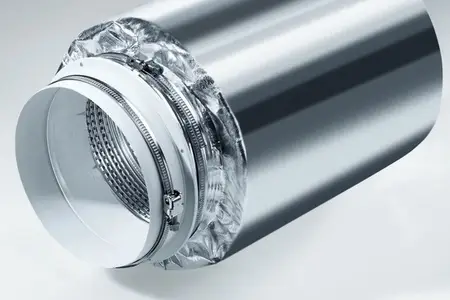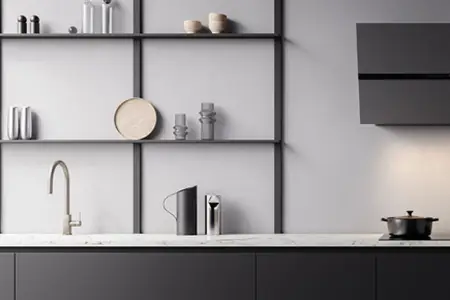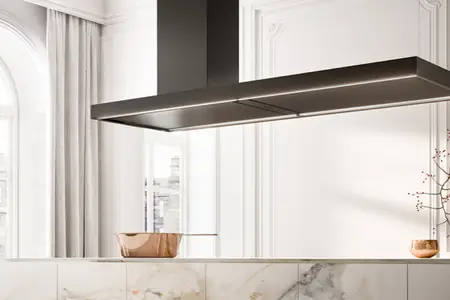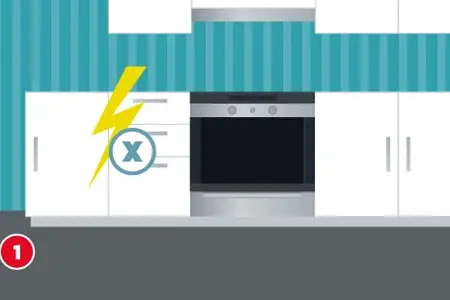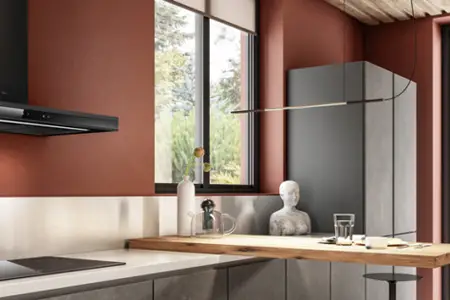In almost every kitchen there is one, and yet there are many questions about range hoods. Do you really need one or can you do without? Because “in the past we managed without…” “Hoods are ugly, noisy and useless”, “They need constant cleaning”, “The filters need to be cut to size”…
However, range hoods are extremely effective at removing particles and odors. An important aspect that is often overlooked is energy efficiency. While exhaust-air range hoods are particularly effective at eliminating odors, they can have disadvantages in terms of energy efficiency.
Why is Ventilation Needed?
The main task of a range hood is to filter or vent cooking odors, vapors, and grease particles from the air. Without an exhaust hood, odors and vapors would spread throughout the kitchen and living space, potentially damaging surfaces, walls, and furniture over time. The range hood ensures a clean indoor climate and reduces exposure to cooking odors and moisture.
Removal of Cooking Vapors
Cooking often produces vapors and grease residues that can settle on kitchen cabinets, walls, and other surfaces without ventilation. These residues are not only unhygienic but can also lead to stains or mold growth in the long term. A range hood prevents steam and grease from spreading throughout the room, keeping the kitchen clean.
Elimination of Odors
Cooking can create intense odors that easily spread throughout open-plan kitchens and apartments without a range hood. Odors from fried fish, garlic, or intense spices can be particularly persistent and aren’t pleasant for everyone. A range hood ensures quick removal of cooking odors before they can penetrate upholstered furniture or textiles.
Reduction of Moisture
Cooking produces water vapor that quickly increases humidity in the kitchen. If this steam isn’t vented, it can condense on walls and furniture, contributing to mold growth. A range hood helps reduce moisture and thus prevents moisture damage.
Improvement of Air Quality
By removing cooking vapors, moisture, and odors, a range hood significantly contributes to improving air quality in the kitchen. Good air quality is particularly important for people with allergies or sensitive airways.
Kitchen Hygiene and Cleanliness
By extracting steam and grease particles, your kitchen stays cleaner and more hygienic. Surfaces and kitchen cabinets remain free from grease deposits, which simplifies cleaning and reduces maintenance efforts.
Benefit: Less cleaning effort and a more hygienic kitchen.
Improvement of Indoor Climate
A range hood ensures constant circulation and cleaning of the air, which improves the overall room climate. This is particularly advantageous in open-plan kitchens, as unpleasant odors don’t spread throughout the living space.
A good range hood contributes to increased living comfort. You can cook freely without unpleasant odors, and guests feel more comfortable in a fresh and clean environment.
By reducing moisture and grease deposits, a range hood protects your kitchen and furniture from damage. Over time, moisture and grease can affect the surfaces of kitchen furniture, walls, and ceilings.

What happens if you don’t have a range hood?
A range hood is more than just a technical device – it’s the key to a clean and fresh kitchen. Without a range hood, various problems can arise that affect your kitchen and indoor climate in the long term.
Cooking odors spread
Without a range hood, odors can spread freely throughout the living space. Especially in open kitchens connected to the living area, intense cooking odors can quickly penetrate the room and settle in upholstered furniture, carpets, and curtains. Odors from fried fish, garlic, or certain spices can persist for days and burden the room’s atmosphere.
Consequence: An unpleasant, persistent odor throughout the living space that is difficult to remove and impairs living comfort.
Fat Particles Settle on Surfaces
When frying or deep-frying, fat particles get into the air and, without a range hood, freely settle on surfaces, kitchen cabinets, and appliances. These greasy residues are not only unhygienic but also difficult to remove. In the long term, they can damage materials and lead to unsightly stains and sticky surfaces.
Consequence: Increased cleaning effort and greater strain on surfaces and kitchen furniture, which can be permanently affected.
Increased Humidity and Risk of Mold
Without a range hood, the humidity created during cooking remains in the room. Especially when cooking dishes with lots of water or steam (e.g., soups, pasta, or vegetables), humidity in the kitchen rises quickly. This moisture can condense on walls, windows, and other surfaces, potentially leading to mold growth – a problem that not only damages the building structure but can also be harmful to health.
Consequence: Increased risk of mold formation and moisture damage to walls, ceilings, and furniture.
Impairment of Air Quality
Cooking vapors contain not only odors and fat but also other pollutants released when heating oils and food. Without a range hood, these vapors are not extracted and burden the room’s air quality. Especially in smaller and poorly ventilated kitchens, this can significantly impair air quality and affect well-being.
No More Newspaper on Kitchen Cabinets
While it’s true that people managed without range hoods in the past, did they manage well? Much has changed since then… Cooking produces moisture, fat, and odors. Unlike moisture and odors, fats cannot be ‘aired out.’ They rise during cooking and settle again if not extracted. In the past, housewives would place newspaper on top of kitchen cabinets to collect fat particles. The paper was regularly replaced. Modern range hoods offer various functions that should be considered when purchasing.
Fats End Up in Metal Filters
Today, range hoods have effective grease filters made of aluminum or stainless steel that filter out fats in the first step. Depending on cooking habits, the grease filter must be regularly cleaned in the dishwasher to prevent it from becoming greasy and to maintain its ability to absorb fats from cooking fumes.
Activated Carbon for Odors and Moisture
Moisture and odors can be reduced through open windows, but more effective is either extraction and transport to the outside (exhaust hood) or cleaning through an activated carbon filter (recirculating hood). Exhaust hoods generally clean more effectively than recirculating hoods, though the distance to the outside, i.e., the length of the exhaust pipe, plays a role.
In recirculation mode, activated carbon filters absorb odors and moisture from cooking air. Recirculation filters come in countless variants. Many manufacturers offer regenerable filters that need replacement after about 3 years rather than every 6 months like conventional activated carbon filters.
A range hood does need some cleaning, that’s true. Since the hood is meant to remove substances from the air, it’s self-evident that these substances must also be removed from the hood and filter.
More Than Odors and Moisture
The German manufacturer Berbel has developed a system (Berbel principle) that eliminates the grease filter and instead ‘spins’ the fat into a collection tray by redirecting the air. This only needs regular wiping, eliminating the need for filter cleaning in the dishwasher. The E.ion system from manufacturer Falmec not only filters cooking fumes but also removes smoke, viruses, bacteria, mold spores, and other allergens from the air through ionization. These devices can be particularly interesting for families with smokers or allergy sufferers.

